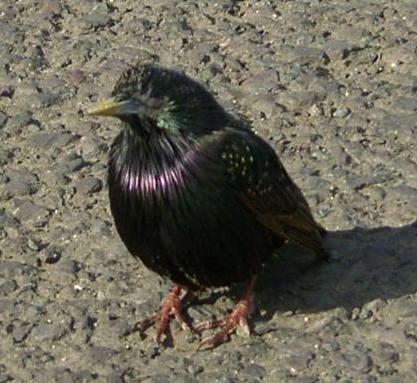Starling
Scientific name: Sturnus vulgaris
Other name: European Starling, Common Starling

A female Starling with more spots on the underside, and a yellow bill.
Starlings are native to most of Europe and western Asia, but have been introduced to North America, South Africa, Australia and New Zealand where they can be regarded as pests by competing with native species and damaging some crops. One hundred birds were released in Central Park, New York in 1890 and 1891 by the American Acclimatization Society whose aim was to introduce to the USA all of the bird species mentioned in the works of Shakespeare. By the 1950s they had spread across the whole country and the current population exceeds two hundred million.
In the garden Starlings can help to remove cutworms such as Leatherjackets, but as they forage they can leave the lawn looking untidy by pulling up thatch and Moss, though not as destructive as Badgers.

A male Starling with its longer throat feathers which are used for display and the greyish base of its bill.
Large flocks of starlings perform an amazing aerobatic spectacle as they return to their roosting site in the evening. This gathering in flight is known as a murmuration which describes the sound produced by the thousands of wings. This is best seen in the winter as the numbers in the British Isles are boosted by migrating starlings which come from the European mainland for the milder climate here. The video below shows an example of this phenomenon. (Click on ![]() bottom right, to expand to full screen.)
bottom right, to expand to full screen.)
Back to GARDEN CREATURES
